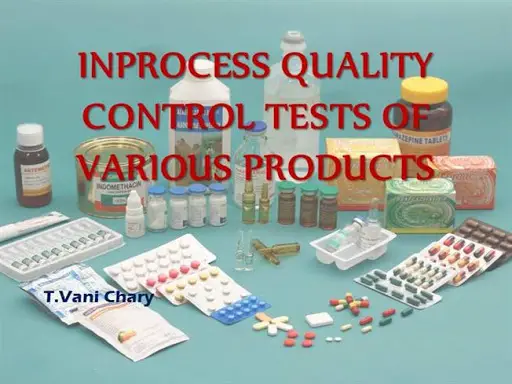- Objective
To lay down the procedure for in-process control of oral drug products during manufacturing & Packing.
- Scope
This procedure is applicable for in-process sampling, analysis, and reporting to be carried out during manufacturing and packing of drug products at the formulation Plant.
- Responsibility
- Quality Assurance and production personnel shall responsible to follow the procedure mentioned in this SOP.
- Accountability
- Head Production & Head QA shall be accountable for the implementation of this SOP.
- Abbreviations and Definitions
| QA | : | Quality Assurance |
| SOP | : | Standard Operating Procedure |
| QC | : | Quality Control |
| LOD | : | Loss on drying |
| DT | : | Disintegration Test |
| BFR | Blister forming Roller | |
| CSR | Counter sealing Roller | |
| PHR | Peripheral Heating Roller | |
| PSR | Pressure sealing Roller | |
| BCP | Batch Coding and Printing | |
| PRC | Print Registration control |
- Procedure
- In-process tests carried out during routine manufacturing of oral dosage forms by Production & QA.
- The in-process tests including the procedure and action are taken if any discrepancy is found shall be mentioned under individual headings & annexures.
- If the processing time for the batch is less than 2 hours, then the in-process checks shall be carried out during the initial, middle, and end of the operation.
- The in-process test shall be carried out at different stages such as:
- For tablet following stage shall be considered in-process – drying, lubrication, compression, coating, Inspection, and packaging operations as per the requirements.
- For Capsule following stage shall be considered in-process -blending, capsules powder filling, packaging operations as per the requirements.
- For Liquid following stage shall be considered in-process -Washing, Bottle filling & sealing, and packaging operations as per the requirements.
- For Ointment following stage shall be considered in-process -tube filling & sealing and packaging operations as per the requirements.
- All the in-process tests conducted during the above-mentioned processes shall be recorded in the respective formats (from Annexure III to IX).
- In-process test parameters shall be considered during routine production i.e. as follows:
- Tablets
| S. No. | Stage | In-process Test | Sample Qty. | Test Frequency |
| 1.
|
Drying | Description | 10 gm. | After completion of drying |
| LOD | ||||
| 2. | Compression | Description | 32 Tablets | For Production
Initial, every 1 hour and at the end of the batch.
For QA Initial, every 2 hours and at the end of the batch. |
| Average weight | ||||
| Uniformity of weight | ||||
| Disintegration Test | ||||
| Hardness | ||||
| Thickness | ||||
| Friability | ||||
| 3. | Coating | Description | 20 Tab. | For Production & QA
After completion of coating of the composite sample |
| Average weight | ||||
| Uniformity of weight | ||||
| Disintegration Test | ||||
| Thickness | ||||
| Weight Gain | 200 Tab. For each lot | For Production
After completion of each lot |
| 4. | Inspection | Challenge test from Metal | – | For Production
Initial, every 1 hour and at the end of the batch.
For QA Initial, every 2 hours and at the end of the batch. |
| Inspection for defects | 20 Tab. | |||
| 5. |
Packing
|
Sealing & forming temp. | – | For Production
Initial, every 2 hours, after every breakdown, and at the end of the batch. |
| Batch coding details | For Production
Initial, every 1 hour and at the end of the batch.
For QA Initial, every 2 hours and at the end of the batch. |
|||
| Defective Tablets, cut pockets, and overprinting | ||||
| Leak Test | Strips from 1 rotation of CSR /blisters from sealing plate sealed per stroke/2 bottles (in case of induction sealing) | For Production
Initial, every 2 hours and at the end of the batch.
For QA Initial, every 4 hours and at the end of the batch. |
- Capsules
| S. No. | Stage | In-process Test | Sample Qty. | Test Frequency |
| 1. | Capsule
filling |
Description | 20 Capsules | For Production
Initial, every 1 hours and at the end of the batch.
For QA Initial, every 2 hours and at the end of the batch. |
| Fill weight | ||||
| Average weight | ||||
| Uniformity of weight | ||||
| DT | ||||
| Locking length | ||||
| 2. | Inspection | Optical Defects | – | |
| 3. | Packing | Sealing & forming temp. | – | For Production
Initial, every 2 hours, after every breakdown, and at the end of the batch. |
| Batch coding details | – | For Production
Initial, every 1 hours and at the end of the batch.
For QA Initial, every 2 hours and at the end of the batch. |
||
| Defective Capsules, cut pockets, and overprinting | ||||
| Leak Test
|
Strips from 1 rotation of CSR / blisters from sealing plate sealed per stroke sealing. | For Production
Initial, every 2 hours and at the end of the batch.
For QA Initial, every 4 hours and at the end of the batch. |
Liquid
| S. No. | Stage | In-process Test | Sample Qty. | Test Frequency |
| 1. | Bottle washing | The volume of water per nozzle per station | 6 nos. of bottles | Initially by production |
| Visual examination of washed bottles | For Production
Initial, every 1 hour and at the end of the batch.
For QA Initial, every 2 hours and at the end of the batch. |
|||
| 1. | Bottle
filling & sealing |
Description | 08 Bottles | |
| Filled volume | ||||
| Leak Test | ||||
| 2. | Inspection | Optical Defects | – | |
| 3. | Packing | Batch coding & overprinting details
|
– | For Production
Initial, every 1 hours and at the end of the batch.
For QA Initial, every 2 hours and at the end of the batch. |
Ointment
| S. No. | Stage | In-process Test | Sample Qty. | Test Frequency |
| 1. | Tube
filling & sealing |
Description | 06 tubes | For Production
Initial, every 1 hour and at the end of the batch.
For QA Initial, every 2 hours and at the end of the batch. |
| Net Content | ||||
| Average fill mass | 20 tubes | |||
| Individual fill mass | ||||
| Batch coding on crimping | ||||
| Loose Capping | ||||
| Crimping | ||||
| 2. | Packing | Batch coding & overprinting details
|
– | For Production
Initial, every 1 hours and at the end of the batch.
For QA Initial, every 2 hours and at the end of the batch. |
- Records
- All the tests conducted during the in-processes shall be recorded in the respective formats. ‘Forms and records’
- Discrepancies during IPQA with their Recommended Action.
- In-Process Tests Including the procedure of Testing is summarized in Annexure
- Forms and Records
- Discrepancies during In-process with their Recommended Action
- In-Process Tests Including the Frequency of Testing
- In Process Control: Tablets
- In-Process Control: Capsules
- In-Process Control: Liquid Filling & Sealing
- In-Process Control: Liquid Packing
- In Process Control: Capsule packing
- In-Process Control: Ointment Filling & Sealing
- In-Process Control: Ointment Packing
- In-Process Control: Tablet packing
- Distribution
- Master Copy – Documentation Cell (QA)
- Controlled Copies – Quality Assurance and Production
- History
| Date | Revision Number |
Reason for Revision |
| – | – | New SOP |
Annexure-I
In case of any deviation follow the SOP on Handling of Deviation
Discrepancies during In-process with their Recommended Action Following are the in-process tests and actions to be taken in case of any discrepancy observed.
| Stage | In-process Test | Action to be taken | |
| Drying/ Blending/ Lubrication | LOD | QA to investigate.
Isolate the container and label it “Under Hold” Withdraw more samples and check. If the results are not satisfactory, perform trials in consultation with Head QA. If the trials meet the specification, continue further processing. The investigation shall be extended to the steps already completed. |
|
| Compression | Appearance, Weight variation, Hardness, Thickness, DT, Friability | Stop the operation
Isolate the container and label it “Under Hold” Investigation by quality assurance by withdrawing samples from various positions from the container. Trials on the existing / next container i.e. in-process testing for all physical parameters. If the samples meet the requirement, continue the processing. The remaining tablets during trial and under hold container will be kept as “Non-recoverable” The investigation shall be extended to the already compressed tablets and if required random sampling shall be carried out from these containers. |
|
| Coating | Appearance, % Weight gain, Thickness,
DT, Average Wt., Uniformity of weight |
Stop the operation
Isolate the lot or batch and label it “Under Hold” Investigation by quality assurance by withdrawing samples from various positions from the container. Trials on the existing / next lot or batch i.e. in-process testing for all physical parameters. If the samples meet the requirement, continue the processing. The investigation shall be extended to the steps already completed. The remaining tablets during trial and under hold container will be kept as “Non-recoverable”. |
|
| Capsule Filling | Lock Length of filled capsule; fill content, average weight, weight variation, moisture content, DT. | Stop the machine
Inform production officer and QA officer. Investigate. Corrective actions e.g. machine settings to rectify the problem. If required take trials on fresh containers. After setting, perform complete in-process analysis for physical parameters. Reject the trial and in-process test samples. The investigation shall be extended to the steps already completed. Continue the processing. |
|
| Packing | Leak Test | Stop machine.
Inform production. QA shall investigate. Corrective actions to rectify the problem. Recheck for leak test from the already packed strips/ blisters at random. If found satisfactory, packing to be continued. If not, then analyze the strips/ blisters for the pack quality and reject. Perform the leak test and if find OK then start the operation. The investigation shall be extended to the steps already completed and if required the random sampling from already packed shippers shall be carried out for leak test. |
|
| Overprinting Details | Stop the machine.
Inform production officer. QA shall investigate. Corrective actions to rectify the problems. Rejection and destruction of all overprinted material. Line clearance by QA. Rechecking of overprinting details after rectification by production officer and QA officer. If required, recheck the packed product if any with random sampling for overprinting details. Continue the packing activity. |
||
| Bottle inspection, induction sealing, Measuring cup placement labeling, weight of the carton and shipper, shipper number. | Stop the machine.
Inform production officer. QA shall investigate. Corrective actions to rectify the problems. Line clearance by QA. Rechecking after rectification by production officer and QA officer. If required, recheck the packed product if any with random sampling. Continue the packing activity. |
||
| Bottle
filling |
Bottle washing, fill weight, cap/closure placement, | Stop the operation
Isolate the bottles and label it “Under Hold”, QA shall investigate. Corrective actions to rectify the problems. Line clearance by QA. Rechecking after rectification by production officer and QA officer. Continue the filling activity. |
|
Annexure-II
In-Process Tests Including the Frequency of Testing
| S.
No. |
Test
parameters |
Sample
quantity |
Procedure |
| 1.
|
Appearance
/ Description for tablets |
20 tablets | Check for defects like surface finish, lamination, mottling, chipping and swelling powder on the tablets embossing (if any), picking, capping and sticking. The appearance of the tablets should comply with that mentioned in the individual specification. |
| 2. | Average Weight | 20 tablets | Weigh individually all tablets, calculate the average weight. |
| Weight variation
(For tablets) |
20 tablets | Weigh one by one 20 tablets and determine the weight variation by subtracting the individual weight of tablets with average weight of each tablets. | |
| 3. | Disintegration
time testing for tablets |
6 tablets | Operate the disintegration tester as per SOP. Place 1 dosage unit in each of the six tube of the basket and, if prescribed add a disk. Operate the apparatus, using water or the specified medium as the immersion fluid, maintain temperature at 37+2ºC or given in specification. At the end of the time limit specified, lift the basket from the fluid, and observed the tablets. All of the tablets have disintegrated completely. If 1or 2 tablets fail to disintegrate completely, repeat the test on 12 additional tablets. The requirement is met if not less than 16 of the total of 18 tablets are disintegrated. |
| 4. | Hardness
Testing |
6 tablets | Hardness test shall be performed with the help of tablet hardness tester as per SOP number _____________ |
| 5. | Thickness testing for compressed/ coated tablets | 6 tablets | Thickness shall be determined using vernier caliper/ digital tablet hardness tester as per SOP number _________. |
| 6. | Friability test | Tablets with a unit mass equal to or less than 650 mg, take a sample of Whole Tablets Corresponding to 6.5 g. For Tablets with a Unit mass of More Than 650 mg, take a sample of 10 Whole Tablets. | The tablets should be Carefully de-dusted prior to testing. Accurately weigh the tablets sample, and place the tablets in the drum. Rotate the drum 100 times, and remove the tablets. Remove any loose dust from the tablets and accurately weigh.
Operate friability test apparatus as per SOP number __________ |
| 7. | Weight gain of coated tablets | 100 tablets | Take weight of 100 pre warmed tablets and Weigh the 100 coated tablets. Calculate the weight gain. |
| 8. | Appearance /
Description for capsules |
20 capsules | Take about 20 capsules at random check for defects like dented capsules, telescopic capsules, empty capsules, capsules with notch, printing quality, crust / lump formation in the blend, improper colour distribution of the blend, powder leaking from the locking end and powder on capsules. The appearance of the capsules should comply with that mentioned in the individual Specification. |
| 9. | Disintegration
time testing for capsules |
6 capsules | Introduce 1 capsule in to each tube and operate the disintegration tester as per SOP number _______. Insert disk over each capsule. Operate the apparatus, using water or the specified medium as the immersion fluid, maintain at 37+2ºC. At the end of the time limit specified Capsules pass the test if all of them disintegrate completely. Result reporting is same as for tablets. |
| 10. | Weight variation (For capsules) | 20 capsules | a) Weigh 20 intact capsules individually and determine the average weight.
b) Remove the contents of each capsule with the aid of small brush or plug of cotton. Weigh the emptied shells individually and calculate for each capsule the net weight of its content by subtracting the weight of the shell from respective gross weight, determine the average net content from the sum of the individual net weights. |
| 11. | Appearance /
Description for Syrup & suspension |
Bottle from every head | Examine for lump formation, caking, quality of suspension odour. The appearance should comply with that mentioned in the individual specification. |
| 12. | Lock length of the capsules | 6 capsules | Lock length of the capsules shall be determined using vernier caliper
|
| 13. | Loss on drying (Powders / Granules) | Approximately 2 g or as per specification | Determine the loss on drying with the help of IR moisture analyzer as per respective SOP |
| 14. | Fill weight of syrups | No. of bottles filled while single rotation of dosing wheel | Take Bottles directly from the syrup filling machine and check the fill weight of powder |
| 15. | Leak Test | Strips from 1 rotation of CSR /blisters from sealing plate sealed per stroke/2 bottles (in case of induction sealing)/ Bottles equal to no. of sealing head. | Leak test shall be performed as per SOP number ____ |
| 16. | Bottle Cleanliness | Two bottles/Jar | Visually check the bottles/Jar for their cleanliness |
| 17. | Overprinting details | Random sampling | Visually check the blister, strips, carton, label for batch details, wrinkles, proper pasting, appearance, etc. |
| 18. | Labeling | Random sampling | Visually check the labeling for any defects like Wrinkles/ crumpled/ slanted/ stained or any other abnormal observations. |
| 19. | Leaflet Placement | Two bottles/jars | Visually check whether the leaflet is placed correctly on the bottle cap/ inside the cartons.(as applicable) |
| 20. | Measuring Cup Placement | Two bottles | Visually check whether the Measuring Cup is placed correctly on the bottle. |
| 21. | Tests to be conducted during blister and strip packing | Random sampling | Visually check for any punctures, empty pocket, overprinting details, sealing quality, knurling quality, forming quality, sealing and forming plate and roller temperature. |
| 22. | Carton packing | Random sampling | Visually check for the correct coding, Product details, and weight of the Carton. |
| 23. | Tests to be conducted during shipper packing | Random sampling | Visually check for the correct coding, number of unit packed, proper BOPP taping, shipper number and weight of the shipper. |
| 24. | Metal detector challenge test | Ferrous non-ferrous and S.S. blocks. | Pass ferrous non-ferrous and S.S. blocks through metal detector. Check the blocks whether it is rejected. |
Annexure-III
In-Process Control: Tablet
Stage: Compression
1.0 Description:
Frequency for Description:
For Production: Initial, every 1 hours and at the end of the batch.
For QA: Initial, every 2 hours and at the end of the batch. Every 2 hours)
Test |
Date/ Time | Observations | Done by |
Description |
|||
2.0 Tablets Size Verification:
Frequency for Tablets Size Verification (By Production & QA): Initial Machine setting
| SNo. | Length | Width | Diameter |
| 1 | |||
| 2 | |||
| 3 | |||
| 4 | |||
| 5 | |||
| 6 | |||
| 7 | |||
| 8 | |||
| 9 | |||
| 10 | |||
| Average | |||
| Maximum | |||
| Minimum | |||
| Limit |
3.0 AVERAGE WEIGHT AND UNIFORMITY OF WEIGHT RECORD:
Date : Location : Equipment ID No. :
Product Name : B. No. :
- Size :
Temperature °C : RH : %
Frequency:
For Production: Initial, every 1 hours and at the end of the batch.
For QA: Initial, every 2 hours and at the end of the batch. Every 2 hours).
Sample size=20 tablets Analytical Weighing Balance ID No.:………………
| Date | |||||
| Time | |||||
| Wt. of 20 Tab. | |||||
| Av. Wt. (mg) | |||||
| 1 | |||||
| 2 | |||||
| 3 | |||||
| 4 | |||||
| 5 | |||||
| 6 | |||||
| 7 | |||||
| 8 | |||||
| 9 | |||||
| 10 | |||||
| 11 | |||||
| 12 | |||||
| 13 | |||||
| 14 | |||||
| 15 | |||||
| 16 | |||||
| 17 | |||||
| 18 | |||||
| 19 | |||||
| 20 | |||||
| Max. Wt. (mg) | |||||
| Min. Wt. (mg) | |||||
| Variation + % | |||||
| Variation–– % | |||||
| Checked By |
4.0 Hardness & Friability:
| Parameter | Time→ | |||||
| Limit↓ | Observation | |||||
| Hardness
(Unit:____) |
||||||
| Friability (%) | ||||||
5.0Thickness
|
Tablets |
Thickness | ||||
| Time | |||||
| 1 | |||||
| 2 | |||||
| 3 | |||||
| 4 | |||||
| 5 | |||||
| 6 | |||||
| 7 | |||||
| 8 | |||||
| 9 | |||||
| 10 | |||||
| Average | |||||
| Maximum | |||||
| Minimum | |||||
| Limit | |||||
6.0 Disintegration time
|
Tablets |
Disintegration Time | ||||
| Time | |||||
| 1 | |||||
| 2 | |||||
| 3 | |||||
| 4 | |||||
| 5 | |||||
| 6 | |||||
| Maximum | |||||
| Minimum | |||||
| Checked By | |||||
| Limit | Not More Than 30 minutes | ||||
Frequency for Hardness, Friability, thickness & Disintegration test:
For Production: Initial, every 1 hours and at the end of the batch.
For QA: Initial, every 2 hours and at the end of the batch. Every 2 hours
Stage: Coating
Date : Location : Equipment ID No. :
Product Name : B. No. :
- Size :
Temperature °C : RH : %
Frequency:
For Production: Initial, every 1 hours and at the end of the batch.
For QA :Initial, every 2 hours and at the end of the batch. Every 2 hours)
1.0 Description
| Test | Date/ Time | Lot No. | Observations | Done by |
| Description
(At the end of each lot) |
||||
2.0 Disintegration Test:
| Test | Date/ Time | Lot No. | Observations | Done by |
| Disintegration Test (At the end of each lot) | ||||
3.0 Weight gain of coated tablets:
| Weight gain of coated tablets (At the end of each lot)
Weight gain in % = B – A x 100 = ……… % (Limit……………..) A |
Limit :
|
||||||||||||||
| Lot number → | |||||||||||||||
| Date/ Time → | |||||||||||||||
| Actual Weight of 100 pre-warmed Tablets in g (A) | |||||||||||||||
| Actual Weight of 100 coated tablets in g (B) |
|
|
|
||||||||||||
| Actual % weight gain of 100 coated tablets | |||||||||||||||
| Thickness in mm (At the end of each lot) | Limit (mm): | ||||||||||||||
| Lot number | |||||||||||||||
| Date/ Time | |||||||||||||||
| Minimum (mm) | |||||||||||||||
| Maximum (mm) | |||||||||||||||
| Done by/ date | |||||||||||||||
4.0 AVERAGE WEIGHT AND UNIFORMITY OF WEIGHT RECORD:
Sample size=20 tablets
| Date | ||||||||
| Time | ||||||||
| Wt. of 20 Tab. | ||||||||
| Av. Wt. (mg) | ||||||||
| 1 | 6 | 11 | 16 | |||||
| 2 | 7 | 12 | 17 | |||||
| 3 | 8 | 13 | 18 | |||||
| 4 | 9 | 14 | 19 | |||||
| 5 | 10 | 15 | 20 | |||||
| Max. Wt. (mg) | ||||||||
| Min. Wt. (mg) | ||||||||
| Variation + % | ||||||||
| Variation–– % | ||||||||
| Checked By | ||||||||



